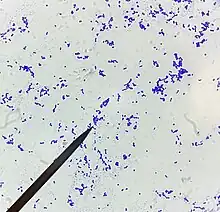Acinetobacter baylyi
Acinetobacter baylyi is a bacterial species of the genus Acinetobacter,[1][2] which was discovered in activated sludge in Victoria, Australia alongside six other new Acinetobacter species.[3] A. baylyi is named after Ronald Bayly, an Australian microbiologist.[3] As with other species of Acinetobacter it is a nonmotile, gram negative coccobacillus. It grows under aerobic conditions, is catalase positive and oxidase negative. The species is natural competent, meaning that it can take up exogenous DNA from its surroundings and incorporate the DNA into its own chromosomal DNA by transformation (genetics).[4]

| Acinetobacter baylyi | |
|---|---|
| Scientific classification | |
| Domain: | Bacteria |
| Phylum: | Pseudomonadota |
| Class: | Gammaproteobacteria |
| Order: | Pseudomonadales |
| Family: | Moraxellaceae |
| Genus: | Acinetobacter |
| Species: | A. baylyi |
| Binomial name | |
| Acinetobacter baylyi Carr et al. 2003 | |
Metabolism
A. baylyi metabolic pathways have been used for many studies in microbial metabolism. This is due to the use of different compounds for metabolism.[5] The use of D-Asp and L-Asp in A. baylyi is an example of this metabolic tolerance for different compounds. A. baylyi is able to use both of these as carbon sources and thus opens the door to see how d enantiomers can be used for bacterial growth.[6] Use of A. baylyi's proteins in heterologous expression inside of E. coli allowed for the bacteria to use the D-enantiomer of Asp as a carbon source.[6]
A. baylyi is known for its fast growth rate and ability to be easily cultured.[4] A. baylyi is also known as an omnipresent bacteria meaning it can be found many places in nature.[2] A. baylyi, specifically the strain ADP1, has been used for over a quarter of a century in several molecular biology studies.[4] For these reasons, A. baylyi is used in multiple laboratory techniques including genetics, such as gene duplication and amplification,[4] and bacterial metabolism.[5][4]
References
- "Genus: Acinetobacter". lpsn.dsmz.de.
- Carr, Emma L.; Kämpfer, Peter; Patel, Bharat K. C.; Gürtler, Volker; Seviour, Robert J. (April 9, 2003). "Seven novel species of Acinetobacter isolated from activated sludge". International Journal of Systematic and Evolutionary Microbiology. 53 (4): 953–963. doi:10.1099/ijs.0.02486-0. PMID 12892111.
- Carr, Emma L.; Kämpfer, Peter; Patel, Bharat K. C.; Gürtler, Volker; Seviour, Robert J. (2003-07-01). "Seven novel species of Acinetobacter isolated from activated sludge". International Journal of Systematic and Evolutionary Microbiology. 53 (4): 953–963. doi:10.1099/ijs.0.02486-0. ISSN 1466-5026. PMID 12892111.
- Elliott, Kathryn T.; Neidle, Ellen L. (April 9, 2011). "Acinetobacter baylyi ADP1: Transforming the choice of model organism". IUBMB Life. 63 (12): 1075–1080. doi:10.1002/iub.530. PMID 22034222.
- Calil Brondani, Juliana; Afful, Derrick; Nune, Hanna; Hart, Jesse; Cook, Shelby; Momany, Cory (June 2023). "Overproduction, purification, and transcriptional activity of recombinant Acinetobacter baylyi ADP1 RNA polymerase holoenzyme". Protein Expression and Purification. 206: 106254. doi:10.1016/j.pep.2023.106254. PMID 36804950. S2CID 257008270.
- Bedore, Stacy R.; Schmidt, Alicia L.; Slarks, Lauren E.; Duscent-Maitland, Chantel V.; Elliott, Kathryn T.; Andresen, Silke; Costa, Flavia G.; Weerth, R. Sophia; Tumen-Velasquez, Melissa P.; Nilsen, Lindsey N.; Dean, Cassandra E.; Karls, Anna C.; Hoover, Timothy R.; Neidle, Ellen L. (2022-08-09). Alexandre, Gladys (ed.). "Regulation of l - and d -Aspartate Transport and Metabolism in Acinetobacter baylyi ADP1". Applied and Environmental Microbiology. 88 (15): e0088322. Bibcode:2022ApEnM..88E.883B. doi:10.1128/aem.00883-22. ISSN 0099-2240. PMC 9361831. PMID 35862682.